PORTRUSH, Northern Ireland — Golf’s oldest championship has been contested for more than 150 years but played at only 14 venues, with just one venturing outside of Great Britain.
For the third time, the British Open will return to Royal Portrush in Northern Ireland after a successful return six years ago when Shane Lowry hoisted the Claret Jug in the rain, an immensely popular Irish victory.
Royal Portrush is one of the 10 venues still in the Open “rota,” having hosted the Open the fewest times. Political strife in Northern Ireland is the most common reason cited for not returning after its first go in 1951, and then the difficulties in staging a modern Open needed to be addressed.
But the R&A, the governing body which runs the tournament, worked with the local authorities and golf club officials to make the necessary changes and was pleased enough to commit to three Opens over time, the second of which will be played this week.
The course has few detractors and was well-received in 2019, its views among the highlights of a venue within an hour of Rory McIlroy’s hometown. Where it ranks among the current Open layouts is a matter of conjecture, with no right answers.
So here’s a subjective list of the 10 now in use followed by the four that no longer host the championship—and some reasons why.
List of the 10 Best Courses in the Open rota
1. The Old Course, St. Andrews, Scotland

Number of Opens: 30
First: 1873
Last: 2022
Prospects: The Old Course has been awarded the 2027 Open
Not everyone is a fan of the layout, which takes some getting used to thanks to its immense subtleties. But St. Andrews is considered the home of golf and the Old Course is one of the game’s true treasures. It is virtually the same place that Old Tom Morris nurtured in the 19th century and the town reeks of golf. It has also produced some high-profile winners: Jack Nicklaus and Tiger Woods each won there twice. Seve Ballesteros won an Open at St. Andrews, as did Nick Faldo. And yet, Arnold Palmer and Tom Watson did not. Cam Smith shot a final-round 64 in 2022 to win the championship.
2. Muirfield, Gullane, Scotland

Number of Opens: 16
First: 1892
Last: 2013
Prospects: Hopeful, but issues persist
Regarded as one of the finest links courses and the fairest of the Open venues, it is properly known as the Honourable Company of Edinburgh Golfers and remains very old school. (The preferred and sometimes required form of play at the course is foursomes, or alternate shot.) The course opened in 1891 and almost immediately became a replacement for nearby Musselburgh. And it’s tough to beat the list of champions: Harry Vardon, Walter Hagen, Gary Player, Jack Nicklaus, Tom Watson, Nick Faldo and Ernie Els. Muirfield was briefly taken out of the running for future Opens until 2017 when it began to admit women members. It is still working through some infrastructure issues with the R&A in order to be awarded its next Open. Phil Mickelson rallied with a final-day 66 to capture the 2013 Open.
3. Royal Birkdale, Southport, England
Number of Opens: 10
First: 1954
Last: 2017
Prospects: Royal Birkdale has been awarded the 2026 Open
Relatively “new” by Open standards, Royal Birkdale is returning after a nine-year gap and has been consistently in the rotation of courses dating to its debut in 1954. Arnold Palmer won the first of his two Opens at Birkdale in 1961 followed 10 years later by Lee Trevino. Branden Grace set a major championship record of 62 (since matched) during the third round of the 2017, which was won by Jordan Spieth in dramatic fashion for his third major championship. The course is also known for holding the 1969 Ryder Cup, where Jack Nicklaus, playing in the competition for the first time, conceded a short putt on the 18th green of the final match to England’s Tony Jacklin, assuring a 16-16 tie.
4. Royal Portrush, Portrush, Northern Ireland
Number of Opens: 2
First: 1951
Last: 2019
Prospects: Royal Portrush is this year’s venue and is assured of at least one more per an agreement with the R&A
Perhaps recency bias is in play here but there is no denying the scenery at Royal Portrush and the way in which the Open was received six years ago. Revenue, as you would expect, is a big part of the R&A mandate and spectators supported in droves and will again this week. Logistical concerns were among the reasons for the absence and those were alleviated by building two new holes with land from an adjacent course. It didn’t hurt that a run of Northern Irish golfers—Graeme McDowell, Rory McIlroy and Darren Clarke—won majors within a 13-month period more than a decade ago. Shane Lowry was the popular home winner in 2019.
5. Royal Troon, Troon, Scotland

Number of Opens: 10
First: 1923
Last: 2024
Prospects: Just a matter of when
Last year’s tournament was an example of how exasperating links golf can be for the best players in the world. The conditions were difficult throughout. Both Rory McIlroy and Bryson DeChambeau missed the cut. The course is next door to Prestwick, which hosted the first Open in 1860, and the two clubs have an annual event in which they start at one course and play through the holes onto the other and back again. Troon has an out-and-back loop similar to the Old Course and is better suited to the demands of a modern Open, hence the decision to leave Prestwick for good more than 100 years ago. Xander Schauffele prevailed last year, winning his second major title.
6. Carnoustie Golf Club, Carnoustie, Scotland

Number of Opens: 8
First: 1931
Last: 2018
Prospects: Murky
Carnoustie’s lack of beauty is made up with brawn. It is generally regarded as the most difficult course on the rota and among the toughest in the world. But the infrastructure issues that caused a long layoff from 1975 to 1999—the period of time between Opens—are in play again as Carnoustie is a tiny town and spectator concerns will make returns likely infrequent. That in no way takes away from the golf course, which is stout. It might be remembered best for Jean Van de Velde’s implosion in 1999. Padraig Harrington won the first of three majors there in 2007, besting Sergio Garcia in a playoff. Ben Hogan completed the “Triple Crown” in 1953 by winning at Carnoustie, the only time he played in the tournament. The last Open played at Carnoustie saw Francesco Molinari—paired with a resurgent Tiger Woods—hold on to win the Claret Jug.
7. Royal Liverpool, Hoylake, England

Number of Opens: 13
First: 1897
Last: 2023
Prospects: A lock for future Opens
The second-oldest seaside links in England, Royal Liverpool was the venue for the first (British) Amateur Championship in 1895 and two of three amateurs who won the Open, Harold Hilton and John Ball, were members at the club known as Hoylake. It is also where Bobby Jones won the second leg of the Grand Slam in 1930. Like Royal Portrush, Royal Liverpool went a long period between Opens, from Robert DeVicenzo’s victory in 1967 to Tiger Woods’s win in 2006. Infrastructure issues were solved and now the course, not far from downtown Liverpool, is a favorite of the R&A for its ability to pack in spectators. Brian Harman prevailed during a rainy week at Hoylake in 2023.
8. Turnberry Ailsa Course, Turnberry, Scotland
Number of Opens: 4
First: 1977
Last: 2009
Prospects: Uneasy
The most recent venue to join the rota, Turnberry was an instant hit in 1977 when it produced a classic, the famous “Duel in the Sun” that saw Tom Watson prevail by a shot over Jack Nicklaus as they played the final 36 holes together and lapped the field by 10 shots. The most picturesque of the venues, Turnberry deserves a higher ranking but is plagued by a couple of big issues, including President Donald Trump’s ownership of the resort, which R&A officials have cited as a reason for pausing a return. But the bigger issue is location and lack of spectator access. The 2009 Open was lightly attended and the R&A has moved more toward higher-revenue producing venues. Watson was 59 years old when he nearly pulled off an incredible victory, ultimately falling to Stewart Cink in a playoff.
9. Royal St. George’s, Sandwich, England

Number of Opens: 15
First: 1984
Last: 2021
Prospects: A 16th Open is just a matter of time
Jack Nicklaus once allegedly said that the Open venues get worse the farther south you go—a line often repeated but never confirmed. The inference was to Royal St. George’s, which is a quirky layout and the first course in England to host the championship. Its proximity to London makes this a lock in the Open rota, even if it might not be the favorite of most players. Despite being located in the tiny town of Sandwich (approximately 5,000 people), the course has vast space for all the Open needs. Collin Morikawa captured the 2021 Open at Royal St. George’s.
10. Royal Lytham & St. Anne’s, Lytham St. Anne’s, England
Number of Opens: 11
First: 1926
Last: 2012
Prospects: Gloomy
Bobby Jones won the first Open at Lytham in 1926 and there was some hope the R&A might return there next year to celebrate the 100th anniversary. But Lytham is plagued by a small footprint that is delaying a return and have put future Opens in peril. Located on England’s northwest coast, the venue itself is solid, with a par-3 opening hole and some 200 bunkers. But organizers need more room and there have been talks about purchasing neighboring or nearby land to accommodate. Until that happens, Lytham is somewhat in limbo, much like Turnberry, Carnoustie and Muirfield. When Ernie Els birdied the 18th hole and Adam Scott bogeyed the last four in 2012, the Big Easy was the winner the last time the Open was at Lytham.
Four others no longer in use
They are not part of the Open rotation anymore, but these four courses still exist and embrace their championship history.
1. Royal Cinque Ports, Deal, England
Number of Opens: 2
First: 1909
Last: 1920
Why it lost the Open: Logistics, proximity of Royal St. George’s
Still regarded as an excellent course, Royal Cinque Ports has been a Final Qualifying venue for the last several years as well as a host for big amateur events. It could clearly still host the Open were it not for the lack of space needed to put on the modern championship. The course lost an Open to world wars in both 1915 and 1938 and was moved in 1949 to Royal St. George’s due to flooding. Deal, as it is also called, was the site for an instructive moment in golf history when Walter Hagen, in 1920, was barred from the clubhouse because he was a pro and required to change in the pro shop. He had his limo driver park in front of the club near a flagpole, where he changed his shoes each day. Hagen would go on to win the Open four times but that week started to change the way pro golfers were viewed. George Duncan won that championship in a two-day event that saw 36 holes played each day.
2. Prestwick Golf Club, Prestwick, Scotland
Number of Opens: 24
First: 1860
Last: 1925
Why it lost the Open: Inability to host large galleries, proximity of Royal Troon.
The original home to the Open Championship, Prestwick is still the second-most used venue in the 152-tournament history of the event. It is no longer suited to hold the championship due to space limitations. The first 12 Opens were played at Prestwick, and 15 of its 24 were played on a 12-hole layout that was not revamped until the late 1880s. (The first Open was contested over 36 holes with the 12-hole course played three times in the same day.) Today just four of the original holes remain but the quirky course is a huge hit with visitors. Among the early tournament lore, Tom Morris Jr. in 1870 won for the third straight time and started the tournament with a 3 on what was then a 578-yard opening hole that played as a par-6. Jim Barnes, who won the first PGA Championship in 1916, won the last Open played at Prestwick in 1925.
3. Prince’s, Sandwich, England
Number of Opens: 1
First and Last: 1932
Why it lost the Open: The course was damaged during World War II and Royal St. George’s became a better option.
When it hosted the Open for the only time in 1932, Prince’s gave the R&A three venues within a few miles of each other (including Royal Cinque Ports). Gene Sarazen set a scoring record that stood for 18 years, led after each round and won by six over Macdonald Smith. But much of the course was destroyed during World War II as the Royal Air Force used it for bombing target practice. Today, the facility is 27 holes and gives the area three incredible Open venues within just a few miles of each other.
4. Musselburgh, Musselburgh, Scotland
Number of Opens: 6
First: 1874
Last: 1889
Why it lost the Open: It is a nine-hole layout that was deemed out of fashion early on as Muirfield took prominence.
The course that is farthest removed from hosting the championship is contained within an existing horse track and still a popular destination for golfers. Its clubhouse across the street is a shrine to its history with the Open. For a time, the championship rotated between Musselburgh, St. Andrews and Prestwick.
Last but certainly not least, Musselburgh goes to the end of the list simply because somebody had to and it is the course farthest removed from hosting the championship, last doing so in 1889. The nine-hole course is a loop which is mostly contained within an existing horse racetrack and it played a big part in the early days of the championship; for a time it was rotated between Musselburgh, St. Andrews and Prestwick. Willie Park Jr. and Andrew Kirkaldy were tied after 36 holes, contested in one day, leading to a 36-hole playoff won three days later by Park. It would be contested over 36 holes just two more times before moving to Muirfield in 1892 for a 72-hole tournament.
The sun setting tonight over the oldest (existing) golf course in the world.
— Jamie Kennedy (@jamierkennedy) July 10, 2025
📍 Old Musselburgh, Scotland.
Just five miles outside of Edinburgh, host of @TheOpen six times, and located within an active horse-racing track.
And yes, you can play it for just £20. pic.twitter.com/WOjdFDxCqN
This article was originally published on www.si.com as Ranking the Best British Open Venues of All Time, Past and Present.
